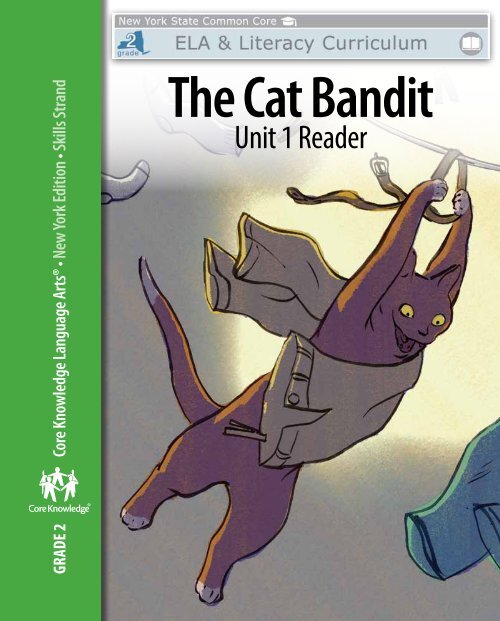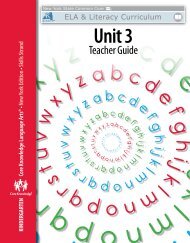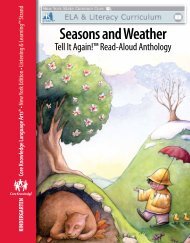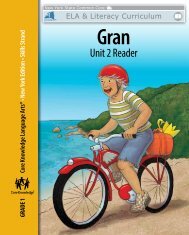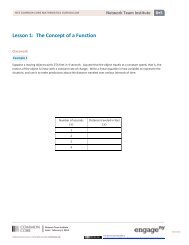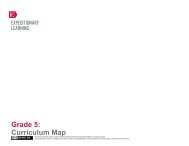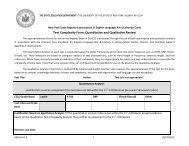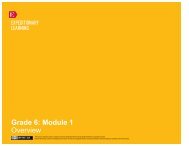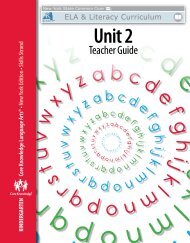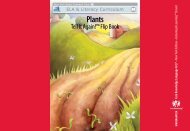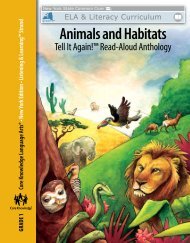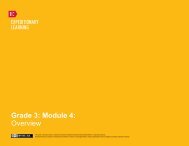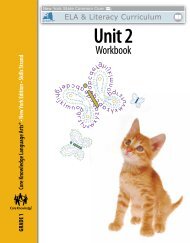Grade 2: Skills Unit 1 Reader - EngageNY
Grade 2: Skills Unit 1 Reader - EngageNY
Grade 2: Skills Unit 1 Reader - EngageNY
You also want an ePaper? Increase the reach of your titles
YUMPU automatically turns print PDFs into web optimized ePapers that Google loves.
<strong>Grade</strong> 2 Core Knowledge Language Arts® • New York Edition • <strong>Skills</strong> Strand<br />
The Cat Bandit<br />
<strong>Unit</strong> 1 <strong>Reader</strong>
THIS BOOK IS THE PROPERTY OF:<br />
STATE<br />
PROVINCE<br />
COUNTY<br />
PARISH<br />
SCHOOL DISTRICT<br />
OTHER<br />
Book No.<br />
Enter information<br />
in spaces<br />
to the left as<br />
instructed.<br />
ISSUED TO<br />
Year<br />
Used<br />
ISSUED<br />
CONDITION<br />
RETURNED<br />
PUPILS to whom this textbook is issued must not write on any page or mark<br />
any part of it in any way, consumable textbooks excepted.<br />
1. Teachers should see that the pupil’s name is clearly written in ink in the<br />
spaces above in every book issued.<br />
2. The following terms should be used in recording the condition of the book:<br />
New; Good; Fair; Poor; Bad.
The Cat Bandit<br />
<strong>Unit</strong> 1 <strong>Reader</strong><br />
<strong>Skills</strong> Strand<br />
<strong>Grade</strong> 2<br />
Core Knowledge Language Arts®<br />
New York Edition
Creative Commons Licensing<br />
This work is licensed under a Creative Commons Attribution-<br />
NonCommercial-ShareAlike 3.0 Unported License.<br />
You are free:<br />
to Share — to copy, distribute and transmit the work<br />
to Remix — to adapt the work<br />
Under the following conditions:<br />
Attribution — You must attribute the work in the<br />
following manner:<br />
This work is based on an original work of the Core<br />
Knowledge® Foundation made available through<br />
licensing under a Creative Commons Attribution-<br />
NonCommercial-ShareAlike 3.0 Unported License. This<br />
does not in any way imply that the Core Knowledge<br />
Foundation endorses this work.<br />
Noncommercial — You may not use this work for<br />
commercial purposes.<br />
Share Alike — If you alter, transform, or build upon this<br />
work, you may distribute the resulting work only under<br />
the same or similar license to this one.<br />
With the understanding that:<br />
For any reuse or distribution, you must make clear to<br />
others the license terms of this work. The best way to<br />
do this is with a link to this web page:<br />
http://creativecommons.org/licenses/by-nc-sa/3.0/<br />
Copyright © 2013 Core Knowledge Foundation<br />
www.coreknowledge.org<br />
All Rights Reserved.<br />
Core Knowledge Language Arts, Listening & Learning,<br />
and Tell It Again! are trademarks of the Core Knowledge<br />
Foundation.<br />
Trademarks and trade names are shown in this book strictly<br />
for illustrative and educational purposes and are the property<br />
of their respective owners. References herein should not<br />
be regarded as affecting the validity of said trademarks and<br />
trade names.
Table of Contents<br />
The Cat Bandit<br />
<strong>Unit</strong> 1 <strong>Reader</strong><br />
The Hot Dog.. . . . . . . . . . . . . . . . . . . . . . . . . . 2<br />
The Chicken Nugget .. . . . . . . . . . . . . . . . . . . . 6<br />
The Snack Mix.. . . . . . . . . . . . . . . . . . . . . . . . 10<br />
The Ham.. . . . . . . . . . . . . . . . . . . . . . . . . . . . 16<br />
The Fish.. . . . . . . . . . . . . . . . . . . . . . . . . . . . . 22<br />
The Milk.. . . . . . . . . . . . . . . . . . . . . . . . . . . . 28<br />
The Chips .. . . . . . . . . . . . . . . . . . . . . . . . . . . 34<br />
The Catfish .. . . . . . . . . . . . . . . . . . . . . . . . . . 40
Mom had a hot dog.<br />
The Hot Dog<br />
She left the hot dog on a shelf in the den.<br />
The hot dog sent up a smell.<br />
The smell drifted and drifted.<br />
The cat bandit sat on the deck, wishing he had<br />
a snack.<br />
Then the hot dog smell hit him.<br />
Such a smell!<br />
Sniff, sniff, sniff!<br />
2
The cat bandit ran in the den.<br />
He spotted the hot dog up on the shelf.<br />
He got up on a bench.<br />
Then he sprang up on the TV set.<br />
Then, with a big jump, he sprang up and landed<br />
on the shelf.<br />
Then—munch, munch, munch—the cat bandit<br />
had himself a picnic lunch.<br />
4
The Chicken Nugget<br />
Hank set his dish in the sink.<br />
He left a big chicken nugget on the dish.<br />
The nugget was still hot.<br />
The smell of chicken drifted up from the sink.<br />
It drifted into the den.<br />
The cat bandit was napping in the den.<br />
But he was sniffing as he slept.<br />
Sniff, sniff, sniff!<br />
6
The cat bandit sprang up.<br />
He ran in and spotted the nugget in the sink.<br />
He sat a bit, thinking up a plan.<br />
Then he went to the closet and got a bunch of<br />
boxes.<br />
He set up a box.<br />
Then he set a big box next to that box.<br />
Then he set the biggest box next to the sink.<br />
The cat bandit set off running.<br />
He ran up the boxes, hopping from box to box.<br />
Then—munch, munch, munch—that was the<br />
end of the chicken nugget.<br />
8
The Snack Mix<br />
Beth left a basket of snack mix on a shelf.<br />
The cat bandit spotted the snack mix.<br />
He felt he had to get it.<br />
But how?<br />
He sat thinking.<br />
Then he got up and ran off to the deck.<br />
10
The cat bandit got the grilling tongs Dad kept<br />
next to the gas grill.<br />
He set the tongs up on the rug.<br />
Then he went and got a bunch of rocks.<br />
He set the rocks on the rug.<br />
He got a rock and set it down on the top tong.<br />
He set his leg on the top tong to press it down.<br />
Then he let the tong spring up.<br />
Swish! The rock went zipping off.<br />
Bing! The rock hit the shelf.<br />
But it did not hit the basket with the snack mix.<br />
12
The bandit set a rock on the tongs and shot it.<br />
Swish, bing!<br />
Swish, bing!<br />
Swish, bing!<br />
The bandit shot six rocks.<br />
But the rocks did not hit the basket of snack<br />
mix.<br />
At last—swish, smack!<br />
The seventh rock hit the basket.<br />
The basket fell down.<br />
It landed on the rug.<br />
The rug was dotted with snack mix.<br />
Then—chomp, chomp, chomp—that was the<br />
end of the snack mix.<br />
14
The Ham<br />
Mom left a pink ham sitting in a big black pan.<br />
The cat bandit was resting on a quilt when he<br />
got a whiff of the ham.<br />
What was that smell?<br />
It was ham!<br />
Where was the ham?<br />
The cat bandit set off, sniffing as he went.<br />
He went on sniffing until he spotted the ham.<br />
But the ham was up on top.<br />
How was he to get it down?<br />
That was the problem.<br />
16
The cat bandit ran to the closet and got a belt.<br />
Then he ran to the shed and got a strong<br />
magnet.<br />
He stuck the magnet on the end of the belt.<br />
The magnet stuck to the belt.<br />
Then the cat bandit swung the belt.<br />
Clang! The magnet on the end of the belt hit<br />
the pan.<br />
It stuck to the pan.<br />
18
In a flash, the cat bandit was tugging on the<br />
belt.<br />
Tug, tug, tug!<br />
Yank, yank, yank!<br />
At last, the pan slid off.<br />
It fell down and landed with a clang.<br />
Then—munch, munch, munch—that was the<br />
end of the ham.<br />
20
The Fish<br />
Once Mom hung a fish up on a string.<br />
The cat bandit was scratching himself when he<br />
got a whiff of the fish.<br />
Quick as a flash he ran into the kitchen.<br />
The bandit spotted the fish hanging on the<br />
string.<br />
He sat down to think up a plan to get the fish.<br />
22
The cat bandit ran and got Mom’s glasses.<br />
He set the glasses on a bench that was in the<br />
sun.<br />
The sun shone on the two lenses of the glasses.<br />
The lenses glinted in the sun.<br />
The bandit slid the glasses a bit to the left.<br />
He slid the glasses until one of the lenses sent<br />
hot sun flashing onto the string.<br />
Then he sat.<br />
24
The sun from the glasses shone on the string.<br />
The string got hot.<br />
The wax on the string melted.<br />
Then, rip!<br />
The fish fell.<br />
Then—munch, munch, munch—that was the<br />
end of the fish.<br />
26
The Milk<br />
Once Beth left a glass of milk on the deck.<br />
The cat bandit spotted it.<br />
It was up where he could not get it.<br />
The bandit was sad.<br />
But then he spotted a string that ran from the<br />
shed to the deck.<br />
Mom had hung wet socks, wet pants, and a wet<br />
jacket on the string.<br />
The bandit grinned.<br />
28
The cat bandit went and got Dad’s belt.<br />
Then he got up on top of the shed.<br />
He swung the belt on top of the string.<br />
Then he held on to the belt and jumped off the<br />
shed.<br />
Whiz!<br />
The bandit went zipping off on the string.<br />
Pop, pop, pop!<br />
He knocked the socks off the string.<br />
Pop, pop, pop!<br />
He knocked the pants off the string.<br />
Thwack!<br />
He knocked the jacket off the string.<br />
30
At last the bandit went zipping past the milk.<br />
As he went past, he kicked the cup with his leg.<br />
The cup fell on the deck with a crash.<br />
The bandit landed on the deck.<br />
Then—lap, lap, lap—that was the end of the<br />
milk.<br />
32
The Chips<br />
Once Mom left a big bag of chips on the top<br />
shelf in the kitchen.<br />
“The cat will not get them up there,” she said.<br />
But it was not long until the cat bandit was up<br />
to his tricks.<br />
He got a log, a plank, and a big rock.<br />
He set the rock on the bench.<br />
He set the log on the rug next to the bench.<br />
He set the plank on top of the log.<br />
34
Then the bandit sat on one end of the plank.<br />
He slid the rock off the bench.<br />
The rock fell and landed on one end of the<br />
plank.<br />
Smack!<br />
The end of the plank where the rock fell went<br />
down fast.<br />
But the end of the plank the cat bandit was<br />
sitting on popped up, and the cat bandit popped<br />
up with it.<br />
Whiz!<br />
The cat bandit went zipping up.<br />
36
The cat bandit did a flip and landed on top of<br />
the shelf.<br />
Slash! The bandit cut a big gash in the bag.<br />
Then—crunch, crunch, crunch—that was the<br />
end of the chips.<br />
38
The Catfish<br />
Dad went fishing and got a big catfish.<br />
He left the catfish in a bucket.<br />
Then he locked the bucket in the shed.<br />
“There!” he said as he clicked the lock shut.<br />
“This lock will stop the cat!”<br />
40
The tempting smell of fish drifted in the wind.<br />
The cat bandit sensed that there was a fish in<br />
the shed.<br />
He went to visit.<br />
The shed was locked up.<br />
But that did not stop him!<br />
He went and got a belt.<br />
He hitched the end of the belt to the lock and<br />
tugged on it.<br />
But the lock held and the shed just sat there.<br />
42
The cat bandit went and got a dog.<br />
The cat and the dog tugged on the belt.<br />
But still the shed just sat there.<br />
44
The cat bandit went and got a pig.<br />
The cat, the dog, and the pig tugged on the<br />
belt.<br />
That did it.<br />
The shed tilted to the left.<br />
46
Wham! The shed fell with a crash.<br />
Then—munch, munch, munch—that was the<br />
end of the catfish.<br />
48
About This Book<br />
This book has been created for use by students learning to read with the Core<br />
Knowledge Language Arts Program. Readability levels are suitable for early readers.<br />
The book has also been carefully leveled in terms of its “code load,” or the number of<br />
spellings used in the stories.<br />
The English writing system is complex. It uses more than 200 spellings to stand<br />
for 40-odd sounds. Many sounds can be spelled several different ways, and many<br />
spellings can be pronounced several different ways. This book has been designed<br />
to make early reading experiences easier and more productive by using a subset of<br />
the available spellings. It uses only spellings that students have been taught to sound<br />
out as part of their phonics lessons, plus a handful of Tricky Words, which have also<br />
been deliberately introduced in the lessons. This means that the stories will be 100%<br />
decodable if they are assigned at the proper time.<br />
As the students move through the program, they learn new spellings and the “code<br />
load” in the decodable readers increases gradually. The code load graphics on this<br />
page indicate the number of spellings students are expected to know in order to read<br />
the first story of the book and the number of spellings students are expected to know<br />
in order to read the final stories in the book. The columns on the inside back cover<br />
list the specific spellings and Tricky Words students are expected to recognize at the<br />
beginning of this <strong>Reader</strong>. The bullets at the bottom of the inside back cover identify<br />
spellings, Tricky Words, and other topics that are introduced gradually in the unit this<br />
<strong>Reader</strong> accompanies.<br />
Visit us on the web at www.coreknowledge.org<br />
UNIT 1<br />
C O D E<br />
L O A D
Core Knowledge Language Arts<br />
Series Editor-in-Chief<br />
E. D. Hirsch, Jr.<br />
President<br />
Linda Bevilacqua<br />
Editorial Staff<br />
Carolyn Gosse, Senior Editor - Preschool<br />
Khara Turnbull, Materials Development Manager<br />
Michelle L. Warner, Senior Editor - Listening & Learning<br />
Mick Anderson<br />
Robin Blackshire<br />
Maggie Buchanan<br />
Paula Coyner<br />
Sue Fulton<br />
Sara Hunt<br />
Erin Kist<br />
Robin Luecke<br />
Rosie McCormick<br />
Cynthia Peng<br />
Liz Pettit<br />
Ellen Sadler<br />
Deborah Samley<br />
Diane Auger Smith<br />
Sarah Zelinke<br />
Design and Graphics Staff<br />
Scott Ritchie, Creative Director<br />
Kim Berrall<br />
Michael Donegan<br />
Liza Greene<br />
Matt Leech<br />
Bridget Moriarty<br />
Lauren Pack<br />
Consulting Project Management Services<br />
ScribeConcepts.com<br />
Additional Consulting Services<br />
Ang Blanchette<br />
Dorrit Green<br />
Carolyn Pinkerton<br />
Acknowledgments<br />
These materials are the result of the work, advice, and encouragement of numerous individuals over many years. Some of those singled out here already<br />
know the depth of our gratitude; others may be surprised to find themselves thanked publicly for help they gave quietly and generously for the sake of<br />
the enterprise alone. To helpers named and unnamed we are deeply grateful.<br />
Contributors to Earlier Versions of these Materials<br />
Susan B. Albaugh, Kazuko Ashizawa, Nancy Braier, Kathryn M. Cummings, Michelle De Groot, Diana Espinal, Mary E. Forbes, Michael L. Ford,<br />
Ted Hirsch, Danielle Knecht, James K. Lee, Diane Henry Leipzig, Martha G. Mack, Liana Mahoney, Isabel McLean, Steve Morrison, Juliane K. Munson,<br />
Elizabeth B. Rasmussen, Laura Tortorelli, Rachael L. Shaw, Sivan B. Sherman, Miriam E. Vidaver, Catherine S. Whittington, Jeannette A. Williams<br />
We would like to extend special recognition to Program Directors Matthew Davis and Souzanne Wright who were instrumental to the early<br />
development of this program.<br />
Schools<br />
We are truly grateful to the teachers, students, and administrators of the following schools for their willingness to field test these materials and for<br />
their invaluable advice: Capitol View Elementary, Challenge Foundation Academy (IN), Community Academy Public Charter School, Lake Lure Classical<br />
Academy, Lepanto Elementary School, New Holland Core Knowledge Academy, Paramount School of Excellence, Pioneer Challenge Foundation<br />
Academy, New York City PS 26R (The Carteret School), PS 30X (Wilton School), PS 50X (Clara Barton School), PS 96Q, PS 102X (Joseph O. Loretan),<br />
PS 104Q (The Bays Water), PS 214K (Michael Friedsam), PS 223Q (Lyndon B. Johnson School), PS 308K (Clara Cardwell), PS 333Q (Goldie Maple Academy),<br />
Sequoyah Elementary School, South Shore Charter Public School, Spartanburg Charter School, Steed Elementary School, Thomas Jefferson Classical<br />
Academy, Three Oaks Elementary, West Manor Elementary.<br />
And a special thanks to the CKLA Pilot Coordinators Anita Henderson, Yasmin Lugo-Hernandez, and Susan Smith, whose suggestions and day-to-day<br />
support to teachers using these materials in their classrooms was critical.
Credits<br />
Every effort has been taken to trace and acknowledge copyrights. The editors tender their apologies for any accidental infringement<br />
where copyright has proved untraceable. They would be pleased to insert the appropriate acknowledgment in any subsequent edition<br />
of this publication. Trademarks and trade names are shown in this publication for illustrative purposes only and are the property of their<br />
respective owners. The references to trademarks and trade names given herein do not affect their validity.<br />
All photographs are used under license from Shutterstock, Inc. unless otherwise noted.<br />
Writers<br />
Matt Davis<br />
Illustrators<br />
Jed Henry
UNIT 1<br />
Code Knowledge assumed at the beginning of this <strong>Reader</strong>:<br />
Vowel Sounds and<br />
Spellings:<br />
Consonant Sounds<br />
and Spellings:<br />
C O D E<br />
L O A D<br />
/i/ as in sit<br />
/e/ as in bed<br />
/a/ as in hat<br />
/u/ as in but<br />
/o/ as in hot<br />
Tricky Words:<br />
the, a, he, she, we, be,<br />
me<br />
/p/ as in pot, pepper<br />
/b/ as in bat,rubbing<br />
/t/ as in top, mitt<br />
/d/ as in dog, sledding<br />
/k/ as in cat, kid, soccer,<br />
back<br />
/g/ as in get, bigger<br />
/ch/ as in chop<br />
/j/ as in jet<br />
/f/ as in fat, sniff<br />
/v/ as in vet<br />
/s/ as in sit, miss<br />
/z/ as in zip, buzz<br />
/th/ as in thin<br />
/th/ as in them<br />
/m/ as in man,<br />
swimming<br />
/n/ as in not, banner /<br />
ng/ as in song<br />
/h/ as in hot<br />
/w/ as in wet<br />
/l/ as in lip, fill<br />
/r/ as in red, ferret<br />
/y/ as in yes<br />
/sh/ as in ship<br />
/x/ as in tax<br />
Code Knowledge added gradually in the unit for this <strong>Reader</strong>:<br />
• Beginning with “The Hot Dog”: tricky words he, she, we, be, me, the<br />
• Beginning with “The Chicken Nugget”: tricky words was, of, a<br />
• Beginning with “The Snack Mix” Day One: /j/ as in gem, tricky words do, down,<br />
how, two<br />
• Beginning with “The Snack Mix” Day Two: /s/ as in cent<br />
• Beginning with “The Ham”: /qu/ as in quilt, /w/ as in when, /r/ as in wrist, /n/ as in<br />
knock; tricky words what, where, why, from<br />
• Beginning with “The Fish”:/j/ as in fringe, /v/ as in twelve; tricky words once, one<br />
• Beginning with “The Milk” Day One: /s/ as in rinse, prince, /ch/ as in itch<br />
• Beginning with “The Milk” Day Two: /e/ + /d/ as in landed, /t/ as in asked, /d/ as in<br />
filled /ng/ as in pink; tricky words could, would, should<br />
• Beginning with “The Chips”: tricky words there, said, says, word
The Cat Bandit<br />
<strong>Unit</strong> 1 <strong>Reader</strong><br />
<strong>Skills</strong> Strand<br />
grade 2<br />
The Core Knowledge Foundation<br />
www.coreknowledge.org


